Joyful Flowers with Watercolor Pencils – Watch the Video!
This week, I have a free video where I create these joyful flowers with watercolor pencils. These are inspired by fabric prints and are more motif-like than many of my colored pencil pieces. I love this kind of playing with style.

This is a small piece, just 8 x 8 inches. It’s colored freely with watercolor pencils on thick drawing paper.
Joyful Flowers – Watch the Video!
In the video, I talk about finding inspiration for art-making and tell stories about things that have affected my style. I just read abstract painter Darby Bannard‘s quote:
“Inspiration doesn’t follow style, it creates it.”
It made me want to share my thoughts about inspiration and style. I also wanted to create something colorful and cheerful that is not realistic, but more design-oriented. These joyful flowers were fun to make. After drawing the joyful flowers, I made something small to add to my boxes of joy. You can see that little flowery thing in the video too. Watch the video!
This video is a little longer than I usually post, but I personally like to watch long videos, and maybe you do too?
Joyful Coloring
My newest course Joyful Coloring teaches a color-oriented approach to watercolor pencils.
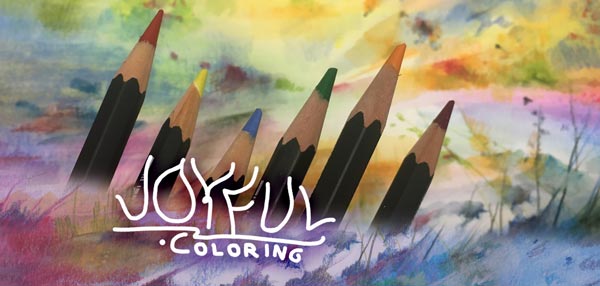
Start with blank paper and create freely with joy and sunshine! >> Buy here!
Revamping Watercolor Painting with Watercolor Pencils
This week, I am revamping an old watercolor painting and sharing some things I have learned over the last five years. Let’s make your paintings more fantastic with five tips!

The size of my example is 28.5 cm x 28.5 cm, so 11.25 inches x 11.25 inches.
Revamping a Watercolor Painting – Best Candidates
Here are the original and the revamped paintings side by side.

I got the idea of the revamp when I was going through my old pieces to find ideas for the new course Joyful Coloring. The watercolor painting from 2019 had good paper and fairly light colors, so I knew it could be revamped quite easily. A part of the revamp is to wipe off some paint, so it helps if the paper is thick and durable. And the fewer layers the painting has, the easier it is to alter it.
Making the Old Version – Watch a Video from 2019!
In this video, I teach the negative painting technique. It’s very useful for watercolor because when you paint around the shape, you can highlight all the lightness and loveliness that has been born in the first layers.
The problem with highlighting the best parts is that we see too many. There’s a mental barrier to paint over them in later layers. And that makes the painting less atmospheric and more busy. Then it also remains less finished-looking than it could be. My painting definitely had these problems. Now I see it as a nice start, but not a finished piece.
Using Watercolor Pencils for Finishing
I could have continued the old painting with watercolors, but I want to grow my skills in using watercolor pencils. So I picked Caran d’Ache Museum Aquarelle pencils, filled a water cup, and chose a couple of narrow brushes. It’s easy to do very detailed things with watercolor pencils so they are suitable for finishing. The watercolor paper of my old painting was the Cold Press quality, so fairly textured, and Hot Press would have worked better for watercolor pencils. But I made the color more even with water, and it worked fine.
You can use any supplies for these tips! Tip #1 is the most important, so start your revamp with it.
Revamp #1 – Less Modesty – Make the Focal Point More Dashing!
What’s the central element in your piece? Is it the best treat of the painting, making you look at it again and again?
Mine was some sort of a daisy, much too modest and simple to my liking, and a bit clumsy too.
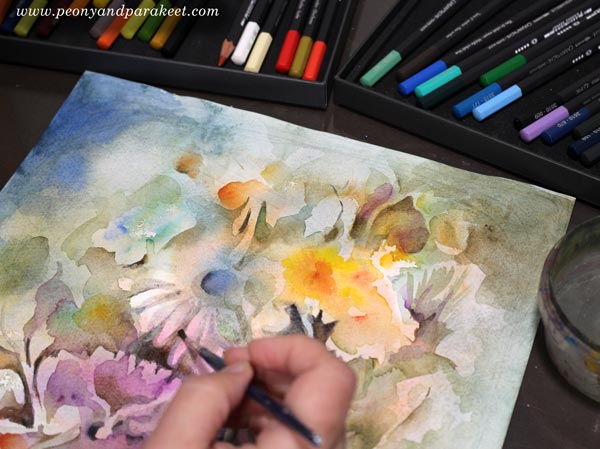
I started wiping off the darkest parts and then made it a peony. It’s a flower that has many layers of petals and is not a shy wallflower at all. Much more eye-catching!

It’s good to arrange some breathing room for the central element and add contrast to the background so that it stands out.
Revamp #2 – Less Bulkiness – Make Shapes More Elegant!
Do you have thick or straight lines? Do the shapes have extra angles? Are the negative shapes (background shapes) as beautiful as the actual shapes? Are many shapes connected to each other?
My painting had a lot of thick stems. Making them narrower immediately adds elegance to the flower. The stems were also very close to the flower and that makes the painting look flat. I added a dark color where the stem and the flower meet so that the flower stands out more.

My old painting had many shapes that looked quite random and not finished at all. I made them more organic and sharper.

But when revamping a watercolor painting, remember that everything doesn’t have to be sharp. The painting can have blurry spots as well, especially near the edges. Blurriness makes the sharp center stand out.
Revamp #3 – Less Evenness – Add More Subtle Patterns!
Have you used only one color on one area? Does your background look boring? Does your piece have an atmosphere?
My old piece had a background that was much too simple for my current taste. It didn’t have a sense of place at all. I want all my paintings to answer the question: “Where am I?” Even if it would be just an imaginary location, at best, the viewer can continue the scenery in her mind.

The background can have patterns. You can pick any idea suitable for fabric design! I wiped off the paint so that I got stripes going in all directions. This kind of bold patterning doesn’t improve the painting right away, but after tip #4, everything will get so much better!
Revamp #4 – Less Separate Color Areas – Add a Dominating Color to the Background!
Are your colors separate islands? Do you see problems in the composition? Is there too much of everything and a need to simplify?
The atmosphere can be often as simple as one color that dominates the background. However, it doesn’t mean that the background only has one tone. You can first add a variety of colors, and then color over them with one color. Separate colors are like strangers, but once they get the same color over them, they become a family. My choice was green, but yours can be any color.

Color a thin top layer so that the lower layers show through. You can color lightly and dilute the color with water.
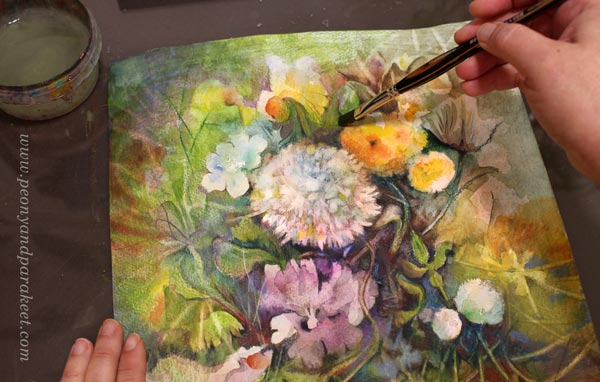
Don’t color over everything though. Leave out the details that you want to keep front!
Revamp #5 – Less Distracting Details – Choose Only a Few Shiny Stars!
Do you still see problems in the composition? Is there still too much to look at? Go through the painting and point your finger to every light and every dark area!
You most probably have too many white or pale pastel areas and/or too many dark areas. If you use high contrasts or very bright colors near the edges, the painting looks busy. Unfortunately, the best details often are born near the edges, but we don’t want the viewer to look there, so we must let them go.
When revamping a watercolor painting, use the dominating background color to cover the less important details. Compare the two pictures below and see how I have reduced the bright spots, for example, the two round flowers in the right bottom corner have been colored green in the final version.


In the center, the contrasts are good. So I made the background near my shiniest star – the peony – darker.
What a difference – isn’t it?!

I hadn’t signed the old painting, but I am so satisfied with the revamped version that I added my signature to it.
Joyful Coloring for Watercolor Pencils
Learn more about using watercolor pencils and create enjoyable projects!

What to Create with Colored Pencils? – Watch the Video!
This week I have a short inspirational video for you. I wanted to make a video that I can share on Instagram, so this has different portions than my videos usually are. You can watch it bigger by pressing the last icon on the menubar below the video.
Most of these drawings are made with regular colored pencils (or crayons as some call them) and some with watercolor pencils. I love both.
Coloring Freely on Blank Paper – Simple Start!
I am an advocate for coloring freely – starting with blank paper, adding colors on top of each other, and getting excited about what comes up. This doesn’t have to be anything difficult. Here’s an old picture from 2015 that I still find inspiring. You can illustrate your journaling with freely colored boxes.
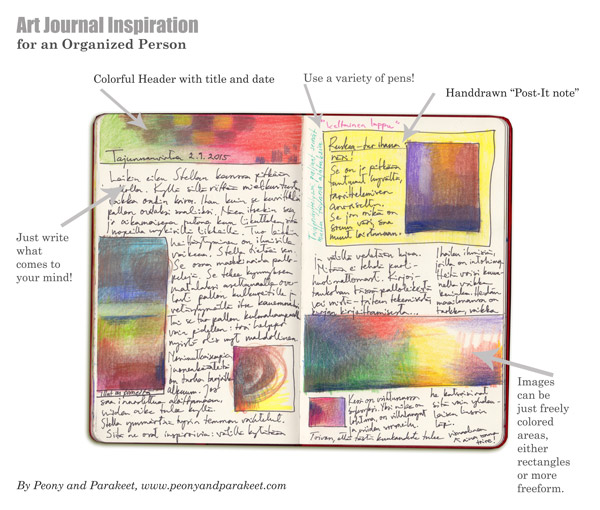
Children draw freely with colored pencils, but when they grow up and become “colored pencil artists” they need all kinds of references to get started. References are great for learning some techniques, but they don’t make anyone an artist. A big part of art is in our mind – how we open up and how we allow ourselves to break boundaries.
Growing Your Skills
My love for colored pencils is based on a promise that I have made for my inner child: I will color for you and help others to color for theirs. So even if I make oil paintings and media art too, colored pencils always have a special place in my heart.

So, welcome to my courses to improve your skills and expand your artistic thinking!
P.S. You can still sign up for Joyful Coloring!

“Start Small”
In the spirit of “Start small”, have you tried this?
Draw lines and color the shapes! Art can be this simple.
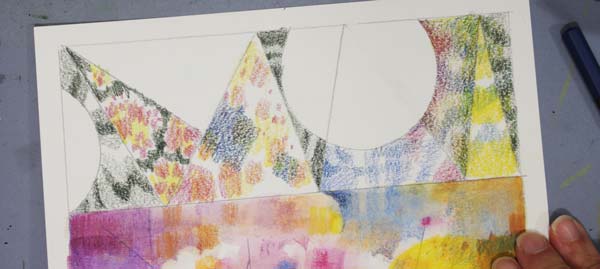
But isn’t it so, that everything just flows when you have the inspiration, and when you don’t, even a simple exercise (picked from the new course Joyful Coloring) can feel tedious.
Browsing for inspiration is never quite the same as participating in a course.
My goal in Joyful Coloring is not only to widen your mind about how you can create
but also to keep your inspiration level up.
Yes, we “start small” but with inspiration, we can also do bigger things.
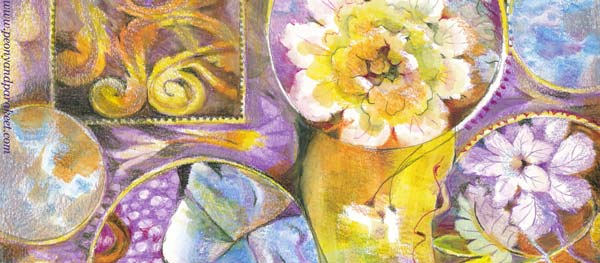
Watercolor pencils feed inspiration because they make coloring faster.
Joyful Coloring
Come with me to start small, and then create landscapes and seascapes, ornamental flowers, colorful fantasies, and modular magic.

Joyful Coloring – The new course begins on Sept 16! >> Sign up Now!